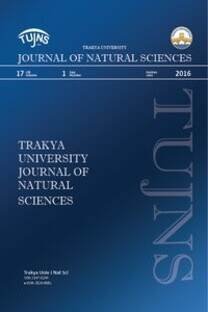Spatial distribution of the forest dormouse (D. nitedula PALLAS, 1778) population in the Bialowieza Forest
orman ekolojisi, yuva yapmak, uzaysal dağılım, lokalizasyon, Polonya, yuva, hayvan davranışları, fareler, mevsimsel değişimler
Bialowieza Ormanı'nda ağaç faresi (D.nitedula PALLAS, 1778) populasyonunun spatial dağılımı
forest ecology, nesting, spatial distribution, localization, Poland, nests, animal behaviour, mice, seasonal variation,
___
- Ajrapetyanc A. E. Soni, Pp. 1-189, Izdatelstvo Leningradskogo Univ. Leningrad. 1983. Andrén H., Delin A. Habitat selection in the Eurasian red squirrel, Sciurus vulgaris, in relation to forest fragmentation. Oikos 70: 43-48, 1994. Angermann R. Zur Ökologie und Biologie des Baumschläfers, Dryomys nitedula (Pallas, 1779) in der Waldsteppenzone. Acta Theriol. 7: 333-367, 1963. Corbet G. B., Southern H. N. The Handbook of Britisch Mammals. Mammal society. Oxford, London, Edinburgh, Melbourne, 1997. Erlinge S. Home range utilization and movements of the Stoat, Mustela erminea. Trans. Game Biol. Congress 13: 31-42, 1977. Gaisler J., Holas V., Homolka M. Ecology and reproduction of Gliridae (Mammalia) in northern Moravia. Folia Zoologica 26 (3): 213-228, 1977. Golodushko B. Z. Materialy po kolcevaniu lesnoj soni v zapovednike “Belovezskaya Pushcha”. In: “Fauna i ekologija nazjemnyh pozvonochnyh Bjelorussii”, Pp. 186-189, Minsk, 1959. Hinde R. A. The Behaviour of the great tit (Parus major) and some other related species. Behaviour, Suppl. 2: 1-201, 1952. Jędrzejewski W., Jędrzejewska B., Szymura L. Weasel population response, home range, and predation on rodents in a deciduous forest in Poland. Ecology 76: 179-195, 1995. Jurczyszyn M., Wołk K. The present of dormice (Myoxidae) in Poland. Nat. Croat. 7: 11-18, 1998. Kryštufek B. Dryomys nitedula. In: Mitchell-Jones A., Amori G., Bogdanowicz W., Kryštufek B., Reijnders P. J. D., Spitzenberger F., Stubbe M., Thissen J. B. M., Vorhalík V., Zima J. The atlas of European mammals, Pp. 300-301, Academic Press T&AD Poyser for the Societas Europaea Mammalogica, 1999. Lozan M., Belik L., Samarskij S. Dormice (Gliridae) of south-west USSR. Kishinev, 1990. Mazurkiewicz M. Spatial organization of the Population. In: Petrusewicz K. (Ed.) Ecology of Bank Vole. Acta Theriol. 28 (Suppl. 1): 117-128, 1983. Niethammer J., Krapp F. Handbuch der Säugetiere Europas. Akademi Verlagsgesellschaft. Wiesbaden, 1978. Nowakowski J. The mapping method – absolute or merely relative numbers? Not. Ornit. 35: 374-387, 1994. Nowakowski W. K., Boratyński P. Habitat preferences of the forest dormouse (Dryomys nitedula) in Lowland forest. Pol. ecol. Stud. 23: 199- 207, 1997. Ognev S. I. Mammals of the USSR and adjacent countries, Vol. 5, Moscov – Leningrad, 1947. Pucek Z. (Ed.). Klucz do rozpoznawania ssaków Polski. PWN. [Key to identification of Mammals of Poland], Warszawa, 1984. Pucek Z., Raczyński J. (Ed.) Atlas rozmieszczenia ssaków w Polsce. PWN. Warszawa [The atlas of distribution of mammals in Poland], 1983. Sidorowicz J. The Forest Dormouse (Dryomys nitedula Pallas) in the Białowieża National Park. Acta Theriol. 3: 17-26, 1959. Storch von G. Familie Gliridae Thomas, 1897 - Schläfer. In: Niethammer J., Krapp F. Handbuch der Säugetiere Europas. Akademie Verlagsgesellschaft, Vol. 1, Pp. 202-280, Wiesbaden, 1978. Wauters L., Casale P., Dhondt A. Space use and dispersal of red squirrels in fragmented habitats. Oikos 69: 140-146, 1994.
- ISSN: 1302-647X
- Yayın Aralığı: 1
- Başlangıç: 2018
- Yayıncı: -
Ecology of the garden dormouse (Eliomys quercinus) inn the alpine habitat
Sandro BERTOLİNO, Italo CURRADO
Ebru BURULDAĞ, Cengiz KURTONUR
Weight changes of the comon dormouse (Muscardinus avellanarius L.) during the year in Lithuania
Dormouse associations in Slovenia-A new approach to an old tradition
Boris KRYSTUFEK, Werner HABERL
Winter activity in the forest dormouse Dryomys nitedula
The vocal repertoire of Graphiurus parvus, and comparisons with other species of dormice
Rainer HUTTERER, Gustav PETERS
An attempt to estimate the size and density of Dryomys nitedula population in the Bialowieza Forest
